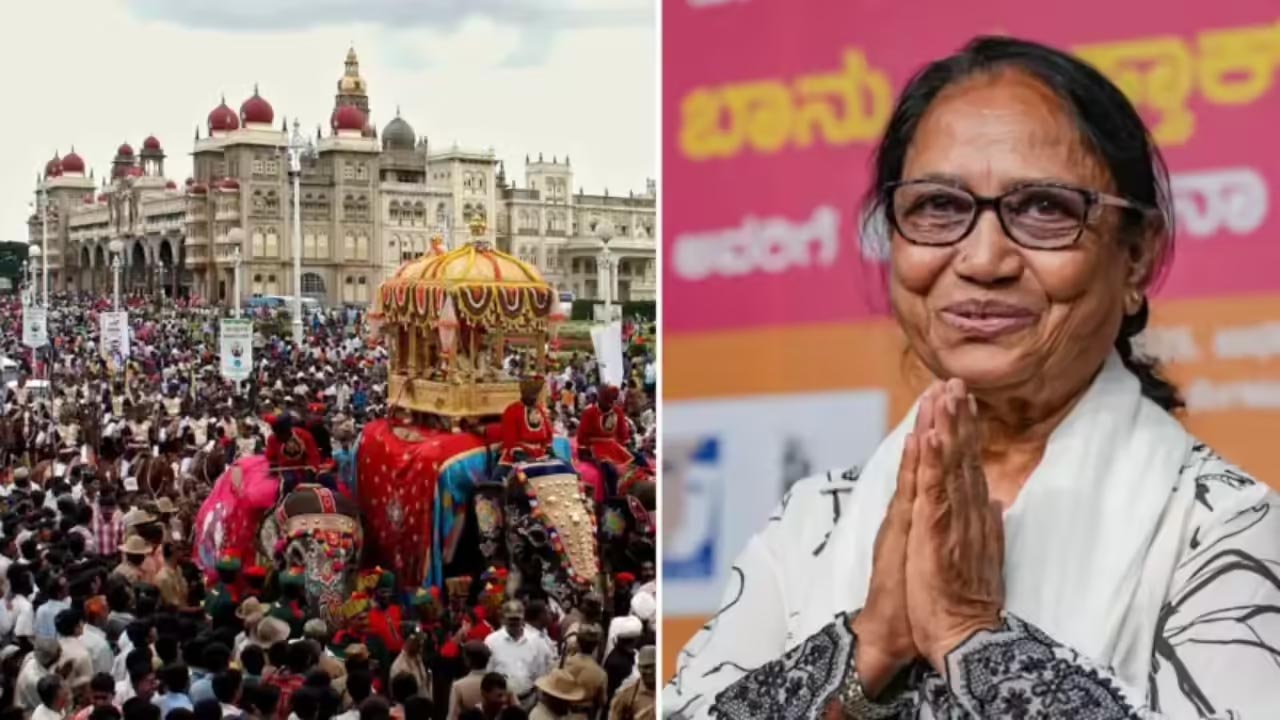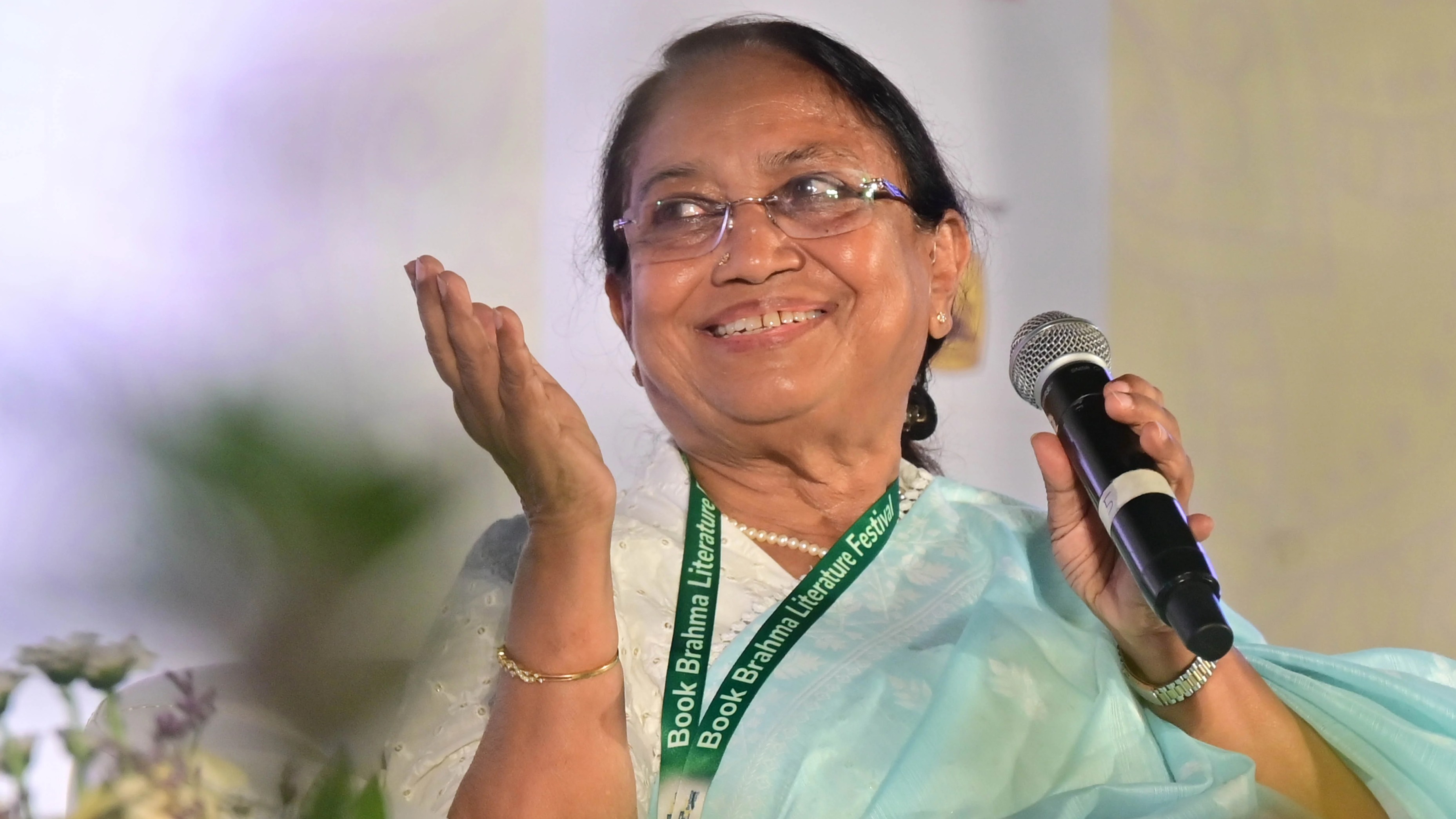Renowned author Banu Mushtaq visited the historic Hasanamba Temple in Hassan, Karnataka, drawing attention from local devotees and literary enthusiasts alike. The temple, famous for its unique architecture and centuries-old traditions, provided an inspiring backdrop for Mushtaq’s visit. Officials from the temple trust welcomed the author and facilitated a guided tour of the sanctum sanctorum, highlighting the rich cultural and religious heritage of the region. The visit coincided with the temple’s annual influx of devotees, allowing Mushtaq to observe rituals, community practices, and the spiritual atmosphere that has sustained the temple’s significance over generations.
During her visit, Banu Mushtaq engaged with local scholars and historians to better understand the temple’s history, legends, and architectural marvels. She expressed appreciation for the temple’s preservation efforts and the community’s devotion, noting how such experiences often inspire her literary work. Mushtaq also shared insights into her writing journey, emphasizing how cultural heritage and historical narratives enrich contemporary storytelling. Her interactions with devotees and temple authorities highlighted the intersection of literature, history, and spirituality, reinforcing the importance of experiential learning for authors seeking to capture authentic cultural narratives.

The visit included participation in traditional rituals and observation of the temple’s daily ceremonial practices. Banu Mushtaq noted the intricacy of the temple’s iconography, sculptures, and architectural design, which reflect a blend of religious symbolism and historical artistry. Temple authorities emphasized that visits from prominent personalities like Mushtaq help promote awareness about the site, attracting both literary tourists and cultural enthusiasts. Local media covered the event extensively, capturing interactions, photographs, and quotes from the author, which will contribute to public appreciation of Hassan’s rich spiritual and cultural landscape.
Community Engagement and Cultural Appreciation
Banu Mushtaq interacted with local devotees, temple staff, and historians, discussing the significance of Hasanamba Temple in regional culture. The discussions highlighted the temple’s role in fostering spiritual and communal harmony across generations.
Officials from the Hassan district tourism and culture departments welcomed the author and emphasized that literary visits help bridge communities, encouraging cultural exchange and promoting heritage tourism. Such interactions contribute to preserving traditional knowledge and fostering appreciation among younger generations.
Literary Inspiration and Future Endeavors
The author expressed intentions to incorporate experiences from Hasanamba Temple into her upcoming literary projects, exploring themes of heritage, spirituality, and human connection. She highlighted how firsthand experiences in historically rich locations add depth and authenticity to narrative writing.
Mushtaq’s visit underscores the potential of literary tourism to promote cultural awareness, heritage preservation, and community engagement. By visiting historically and spiritually significant sites, authors can both contribute to and draw inspiration from India’s rich tapestry of traditions and historical narratives.

Banu Mushtaq’s visit to Hasanamba Temple has sparked considerable interest among literature enthusiasts and cultural scholars. Observers note that such visits by renowned authors can create meaningful connections between literary narratives and historical heritage sites, enriching both the author’s work and public engagement with cultural landmarks. By witnessing rituals, temple architecture, and local traditions firsthand, Mushtaq is able to contextualize historical and spiritual themes that often inform her storytelling.
Local historians emphasized that Hasanamba Temple, built during the Hoysala period, has retained much of its original architectural beauty, including intricately carved pillars and stone sculptures. Mushtaq spent significant time studying these artistic details, noting how they reflect the religious, social, and artistic sensibilities of the era. Scholars believe that such observational insights can enhance literary representations of historical settings, allowing readers to experience cultural depth through narrative.
During her visit, Mushtaq engaged with devotees to understand their experiences and the spiritual significance of daily rituals. Many shared personal stories about the temple’s role in community cohesion, moral guidance, and cultural identity. The author remarked that these narratives offer invaluable perspectives, highlighting how living traditions shape social and cultural consciousness across generations.
The author also participated in evening rituals, observing the ceremonial lighting of lamps and chanting of prayers. She noted the immersive experience of witnessing these practices firsthand, emphasizing that such moments capture the essence of cultural devotion that cannot be fully understood through secondary sources. Experts argue that these observations contribute to authentic storytelling, enabling authors to portray cultural practices with accuracy and sensitivity.
Banu Mushtaq took a keen interest in the temple’s legends and historical accounts, particularly stories associated with the deity Hasanamba and the temple’s founding. Historians guided her through records and manuscripts that provide insights into local governance, religious practices, and socio-political conditions of the Hoysala period. Such historical immersion aids authors in crafting narratives grounded in factual context while maintaining literary creativity.
The author also explored the temple’s surroundings, including its gardens, ancient water tanks, and traditional stone pathways. She expressed admiration for the conservation efforts by the temple trust, which have preserved both the spiritual ambiance and structural integrity of the site. Cultural preservationists note that literary visits raise public awareness about heritage conservation, encouraging citizens and tourists alike to respect and protect historical sites.
Mushtaq engaged in informal discussions with temple staff about the logistics of managing daily rituals, festivals, and visitor influx. These conversations offered her insight into the challenges of maintaining heritage sites while accommodating modern tourism and religious practices. Such practical knowledge often informs her work, providing context for social dynamics and human interactions within historical settings.
The author visited the temple’s library and archives, where she studied manuscripts and inscriptions detailing donations, rituals, and community activities over centuries. Access to these primary sources allows writers like Mushtaq to incorporate nuanced historical and cultural details into their narratives, enhancing both educational value and reader engagement.
Local schools and colleges organized interactive sessions for students to meet the author and discuss her visit. Students posed questions about the temple’s influence on her writing and the importance of cultural preservation in literature. Mushtaq emphasized the role of curiosity, observation, and empathy in understanding living heritage and incorporating it meaningfully into storytelling.
Her visit also highlighted the interplay between literature and tourism, as the presence of a celebrated author drew media attention and increased visitor interest. Tourism officials noted that such literary pilgrimages contribute to cultural tourism, encouraging visitors to explore heritage sites with both educational and recreational intent.
Mushtaq spent time observing traditional art forms associated with the temple, including carvings, sculptures, and ritual instruments. She remarked on the skill and devotion reflected in these art forms, noting that understanding these details enriches her narrative descriptions of historical and cultural settings.
The author’s engagement with local artisans provided insight into the techniques, symbolism, and cultural significance of temple artifacts. By learning directly from practitioners, Mushtaq gained a deeper appreciation for the labor, skill, and spiritual meaning embedded in traditional craftsmanship.
Media coverage of the visit included interviews, photo sessions, and live reporting, bringing attention to both the author and the temple. Experts suggest that such coverage enhances public awareness of cultural heritage and encourages literary tourism, while also inspiring emerging writers to explore historical and spiritual themes in their work.
Banu Mushtaq expressed interest in returning to Hasanamba Temple during festival seasons to witness larger community gatherings and ceremonial events. Experiencing the temple’s festivals firsthand allows authors to capture the vibrancy, devotion, and social cohesion that define local cultural practices.
The visit also included reflective walks around the temple premises, where Mushtaq observed natural features, spatial arrangements, and architectural alignments. These observations are crucial for writers aiming to create immersive, realistic settings that resonate with readers and reflect authentic historical and cultural context.
Her engagement with temple devotees, staff, and historians has provided a rich tapestry of experiences and stories that are likely to influence her future literary projects. Mushtaq emphasized that understanding heritage through direct experience deepens empathy and enhances the storytelling process.
Finally, the author’s visit underscores the broader role of literary tourism in promoting cultural preservation, education, and creative inspiration. By bridging the gap between history, spirituality, and literature, Mushtaq’s engagement with Hasanamba Temple highlights the potential for heritage sites to inform and enrich contemporary artistic expression.
Banu Mushtaq also documented her experiences through sketches and notes, capturing architectural details, inscriptions, and ritual practices. Such documentation serves as a personal archive that may inform her future narratives, providing authentic descriptions and contextual depth.
She engaged with local musicians performing devotional songs, observing the interplay of rhythm, melody, and ritual significance. Mushtaq noted that incorporating musical elements into literature can evoke emotional resonance and enhance cultural authenticity in storytelling.
The author visited nearby historical landmarks connected to Hasanamba Temple, exploring temples, monuments, and community spaces that provide insight into the region’s social and religious fabric. These excursions offered additional context for weaving local history into her literary works.
Mushtaq concluded her visit by expressing gratitude to the temple authorities and local community for their hospitality and openness. She highlighted that such immersive experiences are invaluable for authors seeking to create narratives that honor heritage, culture, and human experience.
Follow: Karnataka Government
Also read: Home | Channel 6 Network – Latest News, Breaking Updates: Politics, Business, Tech & More

